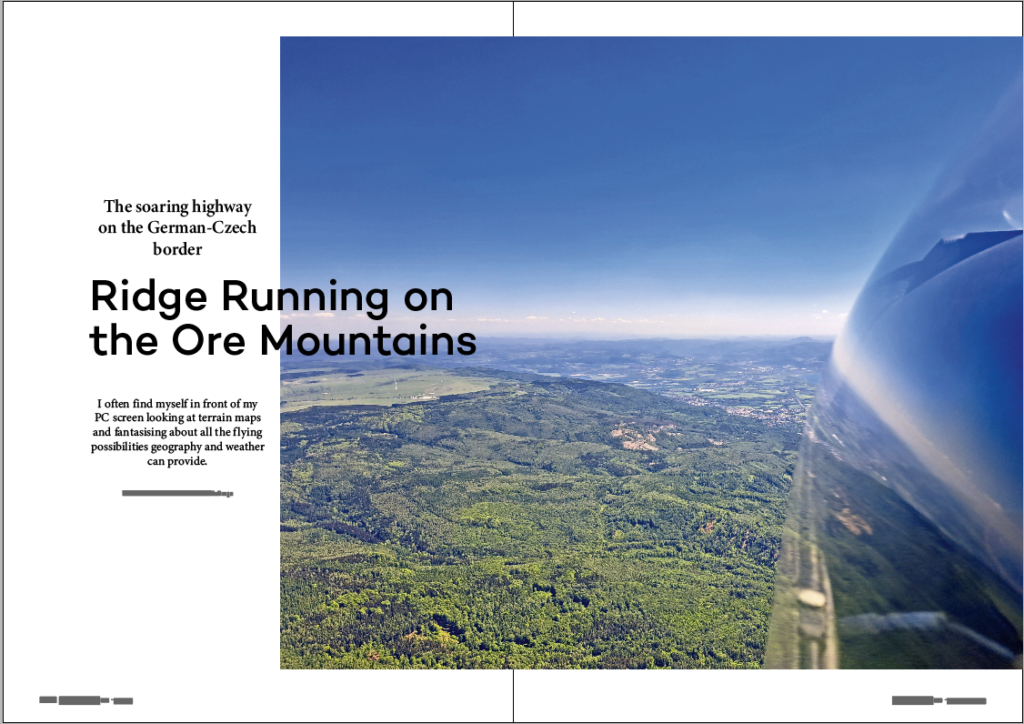
Our authors have once again been extremely busy and have put together interesting, exciting and educational reports for you. Let’s start with high-altitude flights – never fly above 3000 meters without oxygen. Find out here what you need to bear in mind. Then we head to the racetrack along the German-Czech border on the windward side of the Ore Mountains and then accompany a flight across Germany covering 1400 kilometers in two days – and all the while with clean wing edges, right? Do bug wipers really do what they promise? After this report, things are heating up as we experience the “big class” World Championships in Uvalde, Texas, first hand. On the subject of safety, we learn from a failed landing of an LS4. That soaring should be above all fun is proven by our “date” with a sensitive flying machine, the Hütter 17. For those who prefer power, we introduce the Wankel engine: how does the aircraft manufacturer, the technician and the pilot judge it? Now you feel like learning to fly a glider? At over 40 or 50? No problem, as our report shows, because there is no age limit for gliding. As always, we haven’t forgotten our specialists: which parameters influence a winch launch? The focus here is on release height and safety. Finally, we get to dream a little, first about the unique flying experience in Namibia and then about “flying in” over rugged peaks and azure lakes near Sondrio. If you’re quick, you can still secure a place for March 2025! After so much reading material, it’s time to relax: our columnist tells you something about hunter-gatherers today… And now: look forward to the new issue – and if you haven’t subscribed to the magazine: pick it up at the newsstand or order directly at the publishing house.
Take a look at the current issue:

I often find myself in front of my PC screen looking at terrain maps and fantasising about all the flying possibilities geography and weather can provide.
As gliding has been practised in Germany for so long, coming up with new possibilities is a difficult task. After a little research you will most likely find out that someone at some point has already tried what you are envisioning as a possibility.
My Motivation
My story about ridge flying on the Ore Mountains started a few years earlier in November 2019 when during the winter I was checking for opportunities to lengthen the normal gliding season through the winter. A south-easterly wind situation was potentially bringing the possibility for wave flying in the lee of the Ore Mountains and so I started preparing for this event days in advance. After contacting FC Großrückerswalde airfield I made all necessary preparations days in advance (oxygen, airspace check, study terrain, etc.).
After a few years of “hunting” for these kind of special weather situations I learnt a few lessons the hard way. It rarely happens that a forecast is consistent days in advance and usually the weather forecast changes quite a few times until the big day comes. It turned out that the weather forecast deteriorated so much that there was no wave forecast in the Ore Mountains anymore.
Well, trying is half the fun, and succeeding is the other half. By this time, I had already studied the terrain maps of the area and I started questioning whether the windward side (for south-easterly wind conditions) would not provide enough ridge lift to fly along the entire length of the Ore Mountains. A year later, at the 2020 Schwerewelle Symposium, I heard for the first time of the possibility of flying the ridge on the Ore Mountains, and suddenly, my idea comes back to mind.
The weather
So what kind of weather do we need to accomplish a ridge flight in the Ore Mountains? Let’s first have a look at the terrain maps of the region. The ridge line can already be seen standing out in the map below and it spans from south-west towards the north-east. Looking at the ridge orientation, in order to use ridge lift along the Ore Mountains, south-easterly winds are needed. A direction of 152 degrees (give or take) looks ideal and a wind speed of 20 kt should be comfortable enough to keep the glider aloft along the ridge line, even in the areas where the ridge profile is not ideal. Lower wind speeds (15 kt) should also work but I do not know how well this will work on the entire ridge (for example some areas have a less good ridge profile).
In the meantime I was not the only one thinking of flying along this ridge and in 2023 Jan Rothhardt has made a beautiful flight exploiting this weather conditions along the Ore Mountains. A look at the surface pressure charts from two days (20th of March 2023 when Jan Rothhardt flew 540 km at 116 km/h and 15th of May 2024 when Ralf Andrich flew 281 miles at 62 kt) with good conditions along the slopes reveal a low-pressure system above central Europe. The anti-clockwise circulation of the low is bringing the south-easterly winds in the area of the Ore Mountains flowing perpendicular to the ridge.
But how often do we encounter south-easterly winds during the year? A quick look on Windfinder will show us that the weather station at Tušimice/Nechranice reports no predominant south-easterly winds during any month of the year. Therefore the south-easterly winds are not a common event in the area.
The flight
Going back to springtime this year, from the 9th to the 15th of May I was on a small gliding Safari through Germany. I was already for a few days at Bayreuth airfield, and looking at the weather situation, the thermal PFD’s were decreasing day by day, and the outlook was not too optimistic. Some thermals in the weather forecasts, but nothing really great. A quick look at the wind forecasts and I am immediately struck by the strong south easterly winds reported in the area (…)
Exciting? Ok, you can read the whole article in the current issue, which you can order here.

